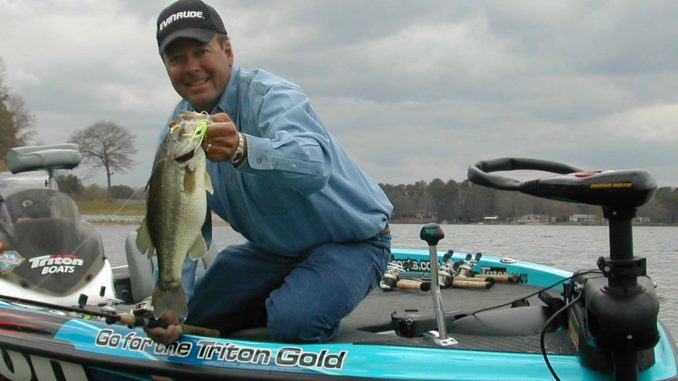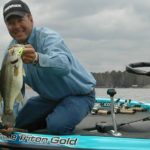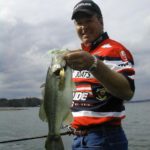
Know where, when, how to fish spinnerbaits
I grew up on the upper end of Lake Murray and spent most of my time fishing up there, because the little johnboat I had didn’t give me the capability of fishing the entire lake. So I got used to fishing stained water, because you get more runoff on that end of most of our lakes in South Carolina, and fishing stained water, I relied an awful lot on a spinnerbait, and I still do, especially in the spring. It’s one of my favorite lures to use when you’ve got stained water. If the water gets really dirty, I’d rather throw a spinnerbait than even a jig because of the vibration of the blades. I’ll definitely have one rigged on a rod that’s on the front deck of my boat.
There are a lot of ways to fish a spinnerbait, a lot of different sizes and colors and blade combinations. The first thing you think about is the depth range you’ll be fishing. Most of the time in March, I’ll be fishing five feet deep or less, but the bass can be anywhere from within two inches of the surface to all the way on the bottom. You need to pay attention to when and where you’re getting bit and adjust the size and makeup of your spinnerbait to keep your bait at the depth you want to fish.
I fish a spinnerbait three ways.
The first thing I’ll do is burn the bait, reel it pretty fast and keep it up within six inches of the surface, maybe even put a ripple on the water. You want to burn a spinnerbait when the fish are going to be active and closer to the surface. A perfect example is when the surface temperature is 65 degrees only a couple of days after it was 60. You get some warm weather and the water in the upper part of the water column is the warmest because the sun is shining on it, and the fish move up there.
The next thing I do with a spinnerbait is slow-roll it. I want to cast that bait, and instead of starting to reel immediately after it hits the water, I might wait for a second or two to let it drop down a couple of feet – especially if I’m fishing in five feet of water. Then, I try to reel it back with a moderate retrieve to try and keep that bait two or three feet deep — in the middle of the water column, where a lot of fish will hold during the prespawn. You want to catch those fish that aren’t quite aggressive enough to chase a bait at the surface. I probably slow-roll a spinnerbait more than I fish it any other way.
The third thing I’ll do with a spinnerbait is just crawl it across the bottom. I like to do that when the surface temperature is 60 but it’s been 65 and we’ve had a cold front that have slowed the fish down. When I crawl a bait and let it sink all the way to the bottom, then engage the reel and turn the handle just fast enough to keep the bait within a foot of the bottom. I’ll stop reeling once or twice during a retrieve and let the bait fall back to the bottom to make sure I’m not getting it too far off the bottom. If it takes more than a couple of seconds to hit the bottom, I’ll know I’m reeling too fast.
So many fishermen just throw a spinnerbait out and reel it back in a foot under the surface every time and never really learn to fish it all the ways you can. You can catch fish on a spinnerbait the way you can on a jig, anywhere from six inches to 20 feet deep.
Now, as far as blades are concerned, you’ve got willow-leaf blades, Colorado blades, Indiana blades, Oklahoma blades, rippled blades, painted blades. You can come up with unlimited combinations, but mostly it will just confuse you. To keep it simple, I like to use two blades: a willow-leaf for flash and a Colorado for vibration. I’ll fish two Colorado blades together, two willow-leaf blades together, or my favorite combination, a Colorado blade in front of a willow-leaf. I get the best of both worlds: vibration and flash.
As far as colors, you can get into a whole lot of different combinations. There are times I want my bait to look like a shad or a bluegill, but most of the time, I think a white/chartreuse combination of bait and skirt is all you need. My favorite bait is a half-ounce chartreuse/white Terminator spinnerbait with a small Colorado blade in front of a willow-leaf blade. I love the titanium wire because it won’t bend out of shape after you catch a fish or two like other spinnerbaits.
I fish a spinnerbait on a 7-foot All-Star spinnerbait rod and a Pfleuger Patriarch baitcasting reel spooled with to 15- to 20-pound Trilene 100 Percent Fluorocarbon. I fish the fluorocarbon because you get a lot better feel; you can feel those blades turning. Plus, it’s more abrasion resistant than regular monofilament. Most of the time, you’re fishing a spinnerbait around visible cover, and on our lakes in the spring, that’s usually wooden cover, so you need the abrasion resistance.
A spinnerbait is a great way to catch lots of active fish, and you can catch big fish on it in the prespawn. My biggest spinnerbait fish was a 10½-pounder I caught the second day of practice for the first Bassmaster tournament I ever won, at Lake Eufala in Alabama. I never caught her again during the tournament, but I had about a 6-pound average the first day, so it didn’t matter. But she was a beauty.
I’m not guaranteeing that you’ll catch a huge fish like that, but a spinnerbait can put you in position to consistently catch spring bass.






Be the first to comment